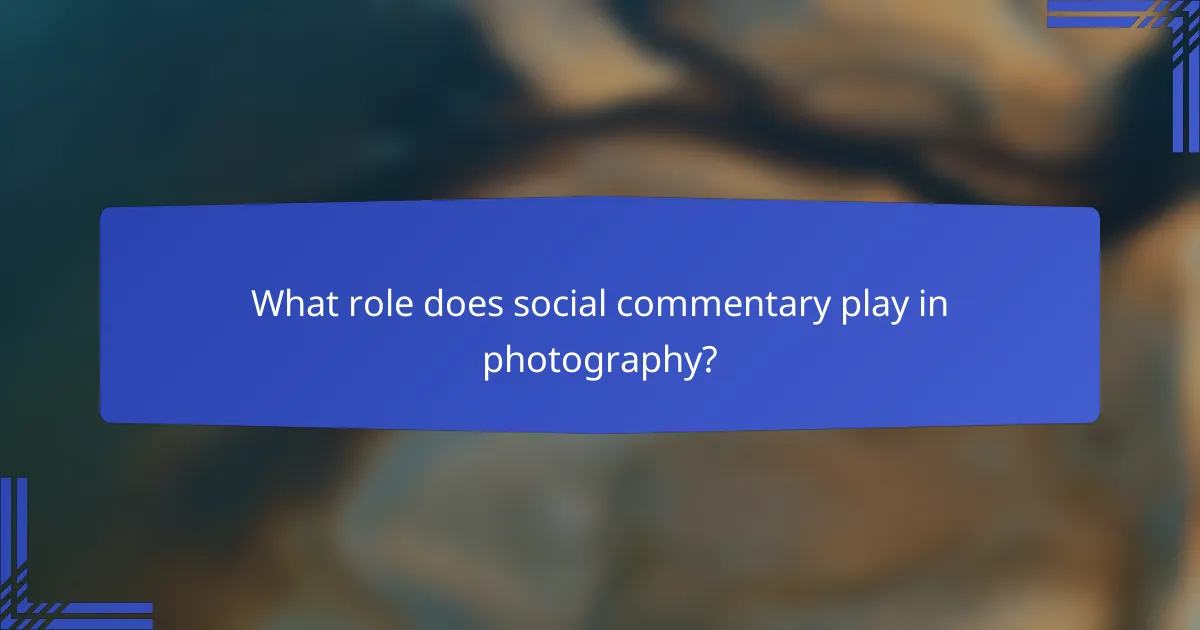Photography serves as a powerful medium for storytelling, particularly through documentary styles that highlight real-life events and social issues. By employing conceptual approaches, photographers can emphasize ideas and provoke critical thought, while social commentary captures the essence of human experiences, urging viewers to reflect on societal dynamics. Each style offers unique perspectives, making photography a vital tool for understanding and engaging with the world around us.

What are the key documentary photography styles?
Documentary photography encompasses various styles that capture real-life events and social issues. Each style has unique characteristics and approaches, making them suitable for different narratives and contexts.
Photojournalism
Photojournalism focuses on capturing newsworthy events and stories through powerful imagery. It aims to inform the public about current affairs, often requiring photographers to work under tight deadlines and in challenging environments.
Key considerations include understanding the ethical implications of your work and ensuring that images convey the truth of the situation. A strong photojournalistic image often combines technical skill with an acute awareness of the unfolding story.
Street photography
Street photography captures candid moments in public spaces, highlighting the everyday lives of individuals and communities. This style emphasizes spontaneity and often reflects social dynamics and cultural nuances.
Photographers should be unobtrusive and respectful, as the goal is to document life as it happens. A successful street photograph often tells a story or evokes emotion, making the viewer feel connected to the scene.
Environmental portraiture
Environmental portraiture combines portrait photography with the subject’s surroundings to provide context about their life or profession. This style helps to tell a more comprehensive story about the individual by showcasing their environment.
When creating environmental portraits, consider the lighting, composition, and how the setting interacts with the subject. A well-executed environmental portrait can reveal much about a person’s character and lifestyle.
Documentary portraiture
Documentary portraiture focuses on capturing the essence of individuals, often in a more intimate and personal manner than traditional portrait photography. This style aims to tell a story about the subject’s life experiences and emotions.
To create compelling documentary portraits, engage with your subjects and build trust. This connection can lead to more authentic expressions and a deeper narrative within the photograph.
Social documentary
Social documentary photography addresses social issues and injustices, aiming to raise awareness and provoke thought. This style often involves long-term projects that explore specific communities or themes, such as poverty, migration, or human rights.
Photographers should approach subjects with sensitivity and respect, ensuring that their work amplifies voices rather than exploiting them. Effective social documentary photography can inspire change and foster empathy among viewers.

How can conceptual photography be approached?
Conceptual photography can be approached by focusing on the idea or concept behind the image rather than just the subject itself. This style often challenges viewers to think critically and interpret the underlying messages conveyed through visual elements.
Surrealism
Surrealism in photography aims to create dream-like scenes that challenge reality. Photographers often manipulate images or combine unexpected elements to evoke emotions and provoke thought. Techniques may include double exposure, unusual juxtapositions, or digital alterations to create a fantastical atmosphere.
To effectively use surrealism, consider incorporating symbolic objects or settings that resonate with personal or universal themes. This approach invites viewers to explore deeper meanings and interpretations, making the work more engaging.
Abstract photography
Abstract photography emphasizes shapes, colors, and forms rather than recognizable subjects. This style encourages viewers to focus on the visual elements and their emotional impact, often leading to varied interpretations. Techniques can include close-ups, unusual angles, or post-processing effects that distort reality.
When creating abstract images, experiment with different compositions and lighting to highlight textures and patterns. Aim for a balance between chaos and harmony to evoke a strong emotional response without relying on identifiable subjects.
Staged photography
Staged photography involves carefully arranging elements within a scene to convey a specific narrative or concept. This approach often includes props, costumes, and controlled lighting to create a desired atmosphere. The goal is to guide the viewer’s understanding of the story being told through the image.
To succeed in staged photography, plan your scenes meticulously, considering every detail that contributes to the overall message. Collaborating with models or artists can enhance the visual storytelling and make the concept more impactful.
Symbolic imagery
Symbolic imagery uses objects or scenes to represent broader ideas or themes, allowing for layered meanings within a photograph. This technique often relies on cultural or personal symbols that resonate with the audience, prompting them to engage with the work on a deeper level.
When incorporating symbolic imagery, choose elements that are meaningful and relevant to your concept. Be mindful of how different audiences may interpret symbols, as cultural contexts can significantly influence perception. Aim for clarity in your message while allowing room for individual interpretation.

What role does social commentary play in photography?
Social commentary in photography serves to provoke thought and inspire change by highlighting societal issues and cultural dynamics. It captures the essence of human experiences, encouraging viewers to reflect on their surroundings and the world at large.
Highlighting social issues
Photography can effectively bring attention to pressing social issues such as poverty, inequality, and injustice. By capturing raw, unfiltered moments, photographers can evoke empathy and raise awareness about conditions that may be overlooked or ignored.
For example, documentary photographers often focus on marginalized communities, showcasing their struggles and resilience. This visual storytelling can mobilize support and foster dialogue around critical topics.
Challenging norms
Photographers can challenge societal norms and stereotypes through their work, pushing boundaries and encouraging viewers to question accepted beliefs. This often involves presenting alternative perspectives that disrupt conventional narratives.
For instance, images that portray gender roles in unexpected ways can spark conversations about equality and representation. By confronting viewers with these challenges, photographers can inspire change and promote inclusivity.
Documenting cultural shifts
Photography plays a crucial role in documenting cultural shifts, capturing the evolution of societal values and practices over time. This visual record can provide insight into how communities adapt to change and the impact of global events.
For example, images from protests or social movements can illustrate the collective response to political or environmental issues. These photographs serve as historical documents that reflect the zeitgeist of their time, preserving the narratives for future generations.

What are the criteria for selecting a photography style?
Selecting a photography style involves evaluating various criteria that align with the intended message and audience. Key factors include subject matter relevance, audience engagement, and technical proficiency, all of which contribute to the effectiveness of the photographic work.
Subject matter relevance
Subject matter relevance is crucial in choosing a photography style, as it determines how well the style conveys the intended message. For instance, documentary photography is effective for capturing real-life events, while conceptual photography may be better suited for abstract themes. Consider the story you want to tell and select a style that enhances that narrative.
When assessing relevance, think about the cultural and social context of your subject. Different styles resonate differently across various demographics, so understanding your subject’s background can guide your choice. For example, a photo essay on social issues may benefit from a documentary approach to highlight authenticity.
Audience engagement
Engaging your audience is essential for impactful photography. The chosen style should resonate with viewers, prompting emotional or intellectual responses. For example, vibrant colors and dynamic compositions in conceptual photography can attract attention, while stark black-and-white images in documentary photography may evoke deeper contemplation.
To enhance audience engagement, consider the preferences and expectations of your target demographic. Tailor your style to align with their interests, whether that means using a more traditional approach for classic art lovers or a modern aesthetic for younger audiences. Testing different styles on small groups can provide valuable feedback.
Technical proficiency
Technical proficiency is a fundamental criterion in selecting a photography style, as it dictates the quality and execution of your work. Understanding the technical aspects of various styles, such as lighting, composition, and post-processing, is essential for achieving desired results. For instance, mastering exposure techniques is critical in documentary photography to capture real-time events accurately.
Evaluate your skill level and the resources available to you. If you are less experienced, starting with simpler styles may be beneficial before progressing to more complex techniques. Additionally, investing time in learning specific skills related to your chosen style can significantly enhance the overall impact of your photography.
